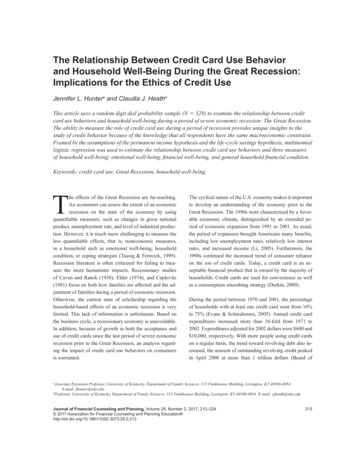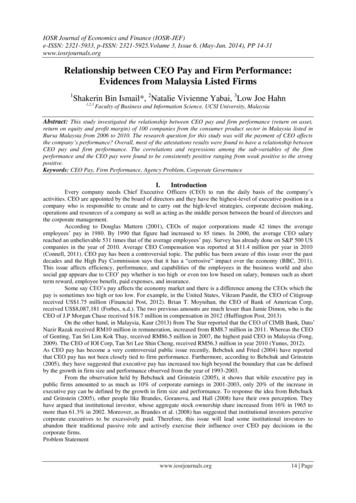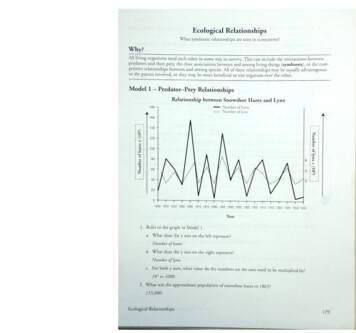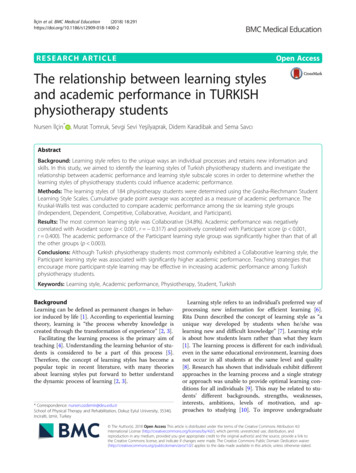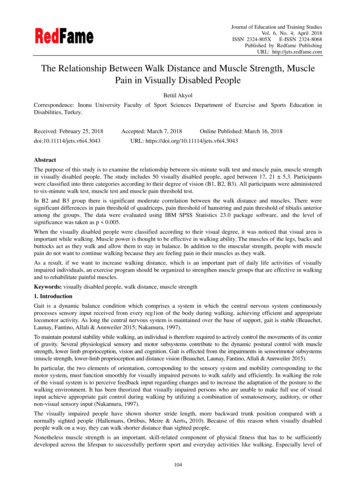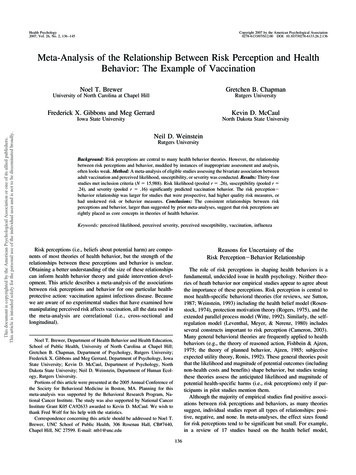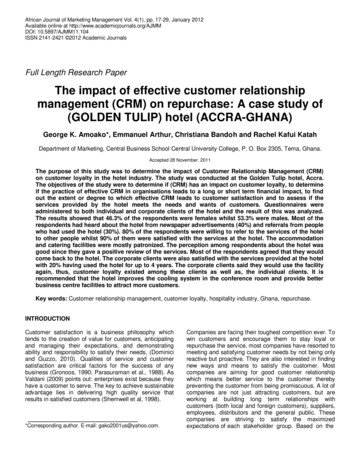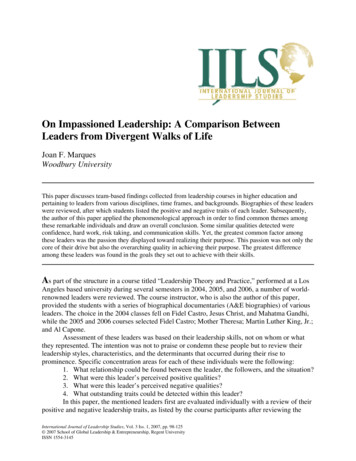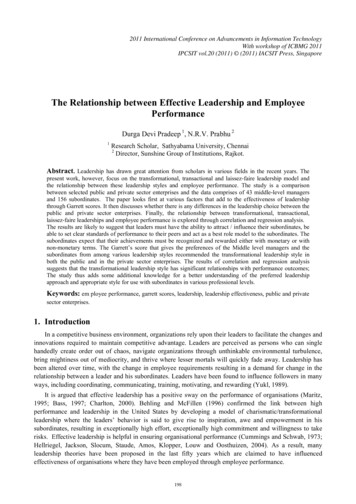
Transcription
2011 International Conference on Advancements in Information TechnologyWith workshop of ICBMG 2011IPCSIT vol.20 (2011) (2011) IACSIT Press, SingaporeThe Relationship between Effective Leadership and EmployeePerformanceDurga Devi Pradeep 1, N.R.V. Prabhu 21Research Scholar, Sathyabama University, Chennai2Director, Sunshine Group of Institutions, Rajkot.Abstract. Leadership has drawn great attention from scholars in various fields in the recent years. Thepresent work, however, focus on the transformational, transactional and laissez‐faire leadership model andthe relationship between these leadership styles and employee performance. The study is a comparisonbetween selected public and private sector enterprises and the data comprises of 43 middle‐level managersand 156 subordinates. The paper looks first at various factors that add to the effectiveness of leadershipthrough Garrett scores. It then discusses whether there is any differences in the leadership choice between thepublic and private sector enterprises. Finally, the relationship between transformational, transactional,laissez‐faire leaderships and employee performance is explored through correlation and regression analysis.The results are likely to suggest that leaders must have the ability to attract / influence their subordinates, beable to set clear standards of performance to their peers and act as a best role model to the subordinates. Thesubordinates expect that their achievements must be recognized and rewarded either with monetary or withnon‐monetary terms. The Garrett’s score that gives the preferences of the Middle level managers and thesubordinates from among various leadership styles recommended the transformational leadership style inboth the public and in the private sector enterprises. The results of correlation and regression analysissuggests that the transformational leadership style has significant relationships with performance outcomes;The study thus adds some additional knowledge for a better understanding of the preferred leadershipapproach and appropriate style for use with subordinates in various professional levels.Keywords: em ployee performance, garrett scores, leadership, leadership effectiveness, public and privatesector enterprises.1. IntroductionIn a competitive business environment, organizations rely upon their leaders to facilitate the changes andinnovations required to maintain competitive advantage. Leaders are perceived as persons who can singlehandedly create order out of chaos, navigate organizations through unthinkable environmental turbulence,bring mightiness out of mediocrity, and thrive where lesser mortals will quickly fade away. Leadership hasbeen altered over time, with the change in employee requirements resulting in a demand for change in therelationship between a leader and his subordinates. Leaders have been found to influence followers in manyways, including coordinating, communicating, training, motivating, and rewarding (Yukl, 1989).It is argued that effective leadership has a positive sway on the performance of organisations (Maritz,1995; Bass, 1997; Charlton, 2000). Behling and McFillen (1996) confirmed the link between highperformance and leadership in the United States by developing a model of charismatic/transformationalleadership where the leaders’ behavior is said to give rise to inspiration, awe and empowerment in hissubordinates, resulting in exceptionally high effort, exceptionally high commitment and willingness to takerisks. Effective leadership is helpful in ensuring organisational performance (Cummings and Schwab, 1973;Hellriegel, Jackson, Slocum, Staude, Amos, Klopper, Louw and Oosthuizen, 2004). As a result, manyleadership theories have been proposed in the last fifty years which are claimed to have influencedeffectiveness of organisations where they have been employed through employee performance.198
The present study adds to the existing literature of finding the extent of relationship between leadershipeffectiveness and employee performance in the Indian context with the following objectives: To ascertain thevarious factors that affects the effectiveness of the existing leadership styles;To determine whether there is any difference in the leadership choice between public and private sectorenterprises; To find out the relationship between effective leadership and employee performance as measuredby extra effort, employee effectiveness, satisfaction and dependability.2.Leadership styles and employee performance – a causal linkThe success of an organisation is reliant on the leader’s ability to optimise human resources. A goodleader understands the importance of employees in achieving the goals of the organisation, and thatmotivating the employees is of paramount importance in achieving these goals.It has been widely accepted that effective organisations require effective leadership and thatorganisational performance will suffer in direct proportion to the neglect of this (Fiedler and House, 1988).Furthermore, it is generally accepted that the effectiveness of any set of people is largely dependent on thequality of its leadership – effective leader behaviour facilitates the attainment of the follower’s desires,which then results in effective performance (Fiedler and House, 1988; Maritz, 1995; Ristow, et al., 1999).Leadership is perhaps the most investigated organisational variable that has a potential impact on employeeperformance (Cummings and Schwab, 1973).A large body of empirical evidences has demonstrated that leadership behaviors influence organizationalperformance that strong leaders outperform weak leaders, and that transformational leadership generateshigher performance than transactional leadership (Burns 1978; Bass 1990; Hater and Bass 1988; Howell andAvolio 1993). Kirkpatrick and Locke (1996) identified over 35 studies reporting positive relationshipsbetween leadership and performance. Transformational leadership or its components have been associatedwith the increases in individual, unit, and/or organizational performance in a variety of meta‐analyses(Lowe et al. 1996), historical archival studies (House et al. 1991), laboratory experiments (Howell and Frost1989; Kirkpatrick and Locke 1996), field experiments (Barling et al. 1996), and field studies (Baum et al.1998; Curphy 1992; Hater and Bass 1988; Howell and Avolio 1993; Keller 1992). Recent leadership studieshave continued to affirm the positive relationship between transformational leadership and performance atvarious levels (e.g., Dumdum et al. 2002; Dvir et al. 2002; Howell et al. 2005). Thus the researchers aim todiscuss whether the transformational leadership does really stimulate the employees for higher performanceor not.The proposed hypothesis is:H01: There is a significant positive relationship between Transformational leadership andEmployee performance.Transactional contingent reward leadership behaviors have also been positively associated withperformance, although to a lesser degree than transformational leadership (Klimoski and Hayes 1980;Podsakoff et al. 1982, 1984; Boerner et al. 2007). Although they are sometimes treated as a dichotomy, it isentirely possible for a given leader to exhibit neither, one, or both transformational or transactionalleadership behaviors in varying degrees, in different situations. From the foregoing the following hypothesisis proposed:H02: There is a significant positive relationship between Transactional leadership andEmployee performance.Bass et al. (1997) conceptualised a third type of leadership, laissez‐faire leadership, which washypothesized to occur when there is an absence or avoidance of leadership. In this case the decisions aredelayed, and reward for involvement is absent. No attempt is made to motivate the followers, or to recogniseand satisfy their needs (Bass & Avolio, 1997). And hence:H03: There is a negative relationship between Laissez‐faire leadership and Employeeperformance.199
3. Methodology of the studyThe data is collected from Fenner (India) Ltd., Madurai, Hindustan Lever Ltd., Pondicherry, SolamalaiAutomobiles Pvt. Ltd., Madurai and TVS (India) Pvt. Ltd., Madurai. A self‐structured questionnaireassessing the various leadership behaviors and employee performance measures were distributed to a randomsample of 215 respondents. A total of N 199 surveys were returned representing a response rate of 92.56per cent. The sample consisted of 43 middle level managers (21.61 per cent) and 156 sub ordinates (78.39per cent) who were under the direct control of the middle level managers. 62.80 per cent of the middle levelmanagers (27 respondents) belonged to the Public sector enterprise whereas 37.2 per cent (16 respondents)belonged to the Private sector enterprises. Likewise, Sixty two per cent of the sub ordinates (96 respondents)belonged to the Public sector and thirty two per cent of the respondents belonged to the Private sectorenterprises who were sixty in actual numbers. Their age ranged from 23 to 37, with a mean age of 32.7.4. Research Instrument and MeasuresThe questionnaire consisted of 50 items out of which 29 items were used to assess the various leadershipbehaviors (transformational, transactional and laissez‐faire leadership behaviors), 11 items wereadministered to measure the employee outcomes (performance) and the remaining 10 items were used toassess the rank scores of various leadership behaviors. In all the cases, Likert’s Five Point scaling rangingfrom “1” (Never) to “5” (Always) was used. In case of Laissez – Faire leadership reverse scoring was usedand for employee performance terms ranging from “Rarely” to “Very Often” was used.5. Leadership measuresTransformational Leadership:Six scales were identified and defined as characteristics of transformational Leadership (Bass 1985; Bass,Avolio, & Goodheim, 1987). They are as follows:Charisma: The leader instills pride, faith and respect, has a gift for seeing what is really important, andtransmits a sense of mission which is effectively articulated.Individualized Consideration: The leader delegates projects to stimulate learning experiences, providescoaching and teaching, and treats each follower as a respected individual.Intellectual Stimulation: The leader arouses followers to think in new ways and emphasizes problemsolving and the use of reasoning before taking action.Inspirational Motivation: The leader provides followers with challenges and meaning for engaging inshared goals and undertakings. Individual Consideration: The leader takes care of each and every follower ofthe group.Confidence: The leader trusts the followers.Transactional Leadership: Three scales are identified and defined as being characteristics oftransactional leadership (Bass, 1985; Bass, Avolio, & Goodheim, 1987):Contingent Reward: The leader provides rewards if followers perform in accordance with the contractor expend the necessary effort.Task Completion: The leader has a firm belief on achieving the goals and that should have higherpriority than any other objectives.Management by Exception (Active): The leader concentrates fully on dealing with employees’mistakes, complaints and failures.Laissez Faire Leadership: Two scales are identified and defined as being characteristic of Laissez –Faire leadership; Management by Exception (Passive): The leader will not interfere in any problems until itbecomes serious.Laissez – Faire: The leaders who have less involvement in performance or who has no involvement at allin performing.200
5.1. Outcome MeasuresExtra Effort: The followers’ interact in putting the efforts which were beyond their ability for higherperformance.Effectiveness: The ability of followers to think more methodically and effectively.Satisfaction: Quantum of satisfaction the followers’ does have with their leaders.Dependability: Ability of the followers to work with Zeal and confidence even in the absence of leaders.6. Data AnalysisDescriptive statistics, Garrett Scores, Correlations and Regression Analysis were used toanalyze the data set. Garret ranking technique was used to convert the order of preference given bythe sample respondents into ranks. The following formula was used to convert the order of merit:Per cent position jjN 100(Rij 0.5)Where,Rij rank given by the jth individual for the ith factor, andNj number of factors ranked by the jth individual.After obtaining the per cent position of each item, it was further converted into scores by usingGarret’s table. The computed scores of the individual respondents for each factor were added anddivided by the total number of respondents who had responded. The mean scores of all the factorsthus arrived at were arranged in a descending order and ranks assigned according to the scoring.The hypotheses framed for the relationship between dependent and independent variables wereanalyzed using correlations and regression analysis.7. Review of LiteratureIn a survey conducted by Bono and Judge (2003) as to whether the followers of transformational leadersexhibit higher performance, motivation, job satisfaction, and organizational commitment in service andmanufacturing organizations, it was found that Transformational Leadership behaviors, as evaluated byfollowers, was positively related to followers’ job performance. From the answers given by the employeesabout the transformational leadership, Nemanich and Keller (2007) concluded that the TransformationalLeadership behaviors had a significantly positive relationship with acquisition acceptance and to bepositively related to goal clarity, creative thinking, and follower performance. The authors suggestTransformational Leadership be used to face challenges, such as those encountered during an acquisition.In a similar study of Piccolo and Colquitt (2006) the authors found Leadership Transformationalbehaviors had a significantly positive relationship with task performance. They also found intrinsicmotivation and goal commitmen
relationship between a leader and his subordinates. Leaders have been found to influence followers in many ways, including coordinating, communicating, training, motivating, and rewarding (Yukl, 1989). It is argued that effective leadership has a positive sway on the performance of organisations (Maritz, 1995; Bass, 1997; Charlton, 2000). Behling and McFillen (1996) confirmed the link between .



